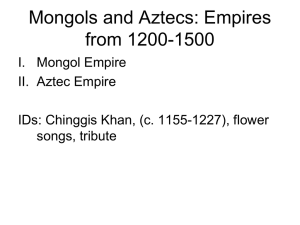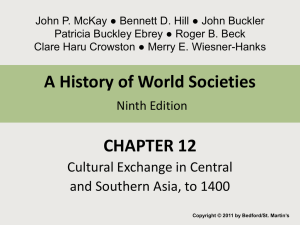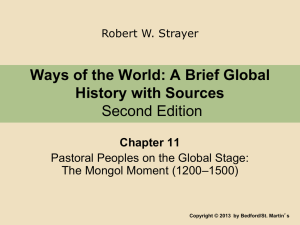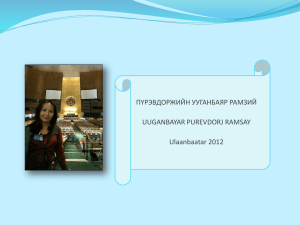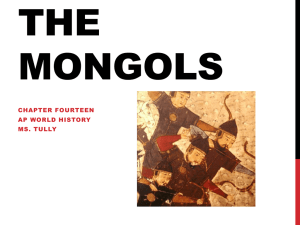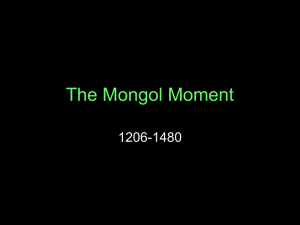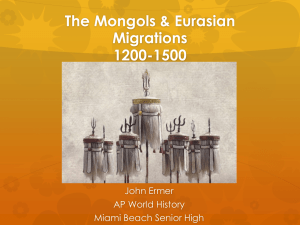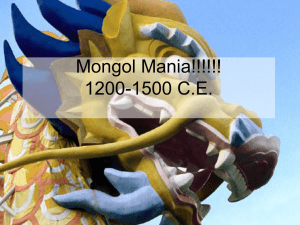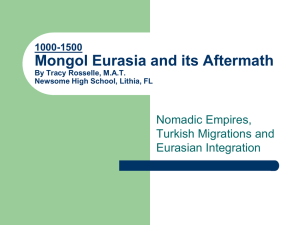Nomadic Empires and Eurasian Integration
advertisement
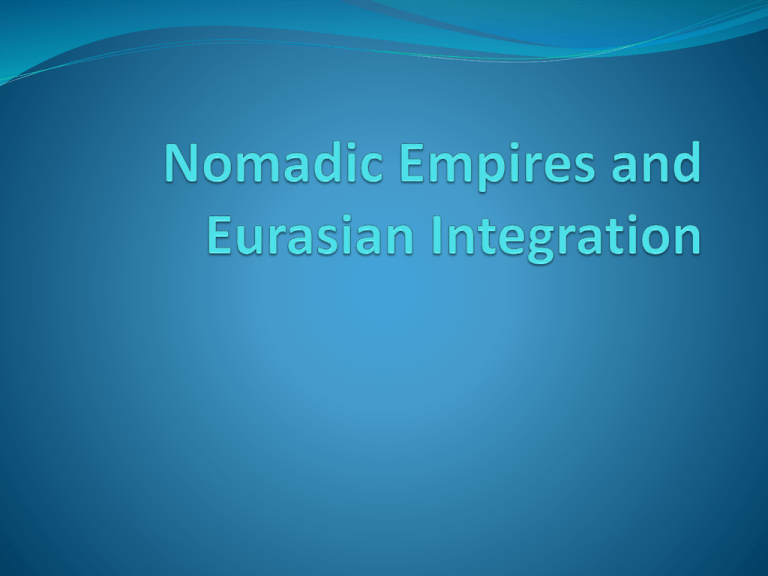
Turkish Migration and Imperial Expansion The Turks were a nomadic group of clans who spoke a similar language and roamed the regions of central Asia from China to Persia. The eventually dominated Persia, Anatolia, and India. Turkish Migrations and Imperial Expansion Nomadic Economy and Society The Asian steppes are primarily high grasslands without rain and rivers to sustain settled communities, so peoples of central Asia followed a nomadic life. Drove herds of sheep, horses, cattle, goats, and camels searching for adequate forage. Lived primarily off of goods from their herds. Eagerly sought trade with settled people to obtain commodities they did not have. Turkish Migrations and Imperial Expansion Nomadic Economy and Society Class Structure Many small clans Consisted of Nobles and Commoners Nobles – Won nobility through military leadership Commoners – Everybody else Each clan governed according to its own needs during times of peace Some clans formed large confederations with alliances to one Khan. Turkish Migrations and Imperial Expansion Military success and Imperial Expansion Horses were the backbone of nomad’s military success Skilled in cavalry warfare, which minimized the impact of their small numbers Great military tactics Allows Turks to begin to expand into settled regions in the tenth century. Turkish Migrations and Imperial Expansion Women in nomadic society Rights comparable to African Women Had some status and autonomy Sometimes engaged in military actions and tactical planning Served as advisors for husbands Could own property and divorce Polygamy (more than one wife) was still the norm and interclan conflict often brought brides through kidnapping. Turkish Migrations and Imperial Expansion Turkic Religion Shamanism – Religious leaders were believed to possess supernatural powers to divine the will of deities and nature as well as intercede on behalf of people. Some Turks later adopted Buddhism, Nestorian Christianity, and Manichaeism. Eventually developed written script to facilitate trade and bring new religious beliefs to conquered areas. Turkish Migrations and Imperial Expansion Turkish Empires in Persia, Anatolia, and India The Turkish nomads were adept at expansion in settled regions of southwest Asia. 10th Century – Turkish armies moved into the Middle East initially as mercenaries of the Abbasid caliphate. Eventually Turkish sultans became powerful. In Anatolia, they defeated the Byzantines and welcomed converts to Islam at the same time that they took on political administration of the region. Mahmud of Ghazni – Raided regions of northwest India for treasure, but later groups of Turks established themselves as the sultanate of Delhi. After Hindu and Buddhist sites had been plundered, many were abandoned so that later Turks for the region ripe for conversion to Islam. The Mongol Empire Allies of the Turkish people, the Mongols of east central Asia did not expand as early as the Turks. In the twelfth century, Chinggis Khan consolidated the Mongol armies into the greatest expansionary force that the world has ever known!!! While the Mongol expansion could not be sustained for more than a few generations, its influence on Asia and Europe was significant. The Mongol Empires Chingghis Khan and the Making of the Mongol Empire 1167 Temujin was born into a noble family, but by the time he was 10 years old his father was poisoned by rivals and his family sunk into poverty. Courageous and Charismatic, Temujin used his diplomacy skills to ally himself with powerful clans and eventually united the Mongols into a single confederation. Afterward, he became known as Chingghis Khan (Universal Ruler). Appointed commanders based on skills and personal loyalty rather than status Created Mongol capital of Karakorum The Mongol Empires Chinggis Khan and the Making of the Mongol Empire Armies were small but powerful Skilled cavalry and archery (while riding horses could hit target up to 200 yards) Used psychological warfare to build empire. Resisting communities were cut down brutally (used as human shields) Surrendered communities treated with relative generosity. The Mongol Empires Chingghis Khan and the Making of the Mongol Empire First used military to attack other nomadic groups in central Asia. Then he set his sights on large empires such as China and Persia Captured most of northern China by 1220 and established Mongol city of Khanbalik (present day Beijing) After the ruling shah of Persia brutalized Mongol ambassadors, Chingghis Khan took revenge and seized Persia. Destroyed the qanat irrigation system and numerous Persian Cities. Chingghis Khan died shortly after leaving behind a large empire with little administration to run it. The Mongol Empires The Mongol Empires after Chingghis Khan Chingghis Khan left many sons and grandsons who competed for rule. After significant power struggles, the Mongol empire was divided into four regions: Great Khans – China Khanate of Chagatai – Central Asian region Khanate of the Golden Horde – Russia Ilkhanate of Persia - Persia The Mongol Empires Mongol Rule in China by the Great Khans Khubilai - Ruler Conquered the southern regions of China Called his admin the Yuan Dynasty Promoted Buddhism Tried to conquer Japan, but failed. The Mongol Empires Golden Horde of Mongols Ruled Russia Attempted expansion into Europe as far as eastern Germany but ultimately settled in the grassland regions north of the Black Sea The Mongol Empires Ilkhanate Empire of Persia Conquered Persia and the Baghdad caliphate Tolerated all religions Allowed administrations to stay in position as long as they collected taxes and maintained order. The Mongol Empires The Mongols and Eurasian Integration Mongols imported talented craftsmen and administrators from newly conquered regions to China and Persia. Thousands of foreigners lived and worked in Mongol cities of Asia. Muslim, Buddhist, and Nestorian Christian faith spread along silk roads. The Mongol Empires Decline of the Mongols in Persia and China Fell because of infighting and financial problems. Bubonic Plague Began in 1330s Wipes out half of the exposed populations Spread along silk roads Devastated Mongol empires. After the Mongols Tamerlane the Whirlwind Built short lived but large empire after the fall of Mongols. Mounted successful campaigns against Persia, Afghanistan, the Golden Horde in Russia, and the sultanate of Delhi. After death succession was problematic and empire fell. After the Mongols The Foundation of the Ottoman Empire Nomadic peoples continued to influence Asia and Europe through the Ottoman Turks. By 1453, they ruled over a vast empire across northern Africa, in southeast Europe and most of the Middle East.
